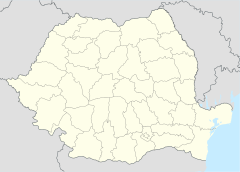Banat Sphinx
| Banat Sphinx | ||
|---|---|---|
| The Banat Sphinx | ||
|
|
||
| Location: | Caraș-Severin , Romania | |
| Next city: | Orșova , Baile Herculane | |
The Banat Sphinx ( Romanian Sfinxul Bănățean , also Sfinxul de la Topleț or Capul Turcului ) is a nature reserve of IUCN Category III, natural monument , on the left Cernaufer , in the Caraș-Severin district , in southwest Romania . The Banat Sphinx is a megalith north of the village of Bârza , in the district of Topleț .
location
The Banat Sphinx is located on the European route E 70 București - Timișoara between Orșova (10 km) and Băile Herculane (7 km), from Băile Herculane downstream in the direction of Topleț, at kilometer stone 380.
description
The Banat Sphinx was declared a natural monument in 1982 and has been part of the Domogled-Valea Cernei National Park since 1990 . It extends over an area of half a hectare and consists of sedimentary rock with steep rock walls and scree .
The vegetation of the reserve has rare species, such as the common lilac ( Syringa vulgaris ), the manna ash ( Fraxinus ornus ) or the windflower mullein ( Verbascum phlomoides ).
The 16 meter high and 8 meter wide megalith, which can be seen from afar, was created over the centuries by wind and water erosion . It owes its name to the resemblance to a human head. The Banat Sphinx is often compared to a helmet- wearing Dacer head .
At the entrance to Topleț you can see the remains of the aqueduct in two places, which the Turks built in 1739 to move the border with Austria further west and to keep Orschowa, which however did not succeed. This is how the first welded curved bridge in Europe was created.
See also
Web links
- rumaenien-tourismus.de , Domogled National Park - Cernatal.
Individual evidence
- ↑ a b eastern-images.de ( Memento of 22 February 2014 Internet Archive ), Georg Hromadka: on scenic trails
- ↑ cesavezi.ro , The Banat Sphinx ( Romanian )
- ↑ karpatenwanderer.de ( Memento from November 26, 2012 in the Internet Archive ), Werner Kremm: Landscape of peculiarities and records.


